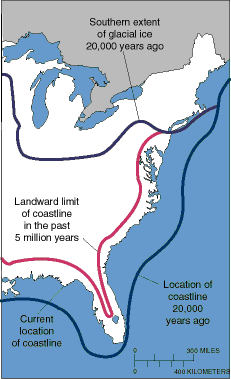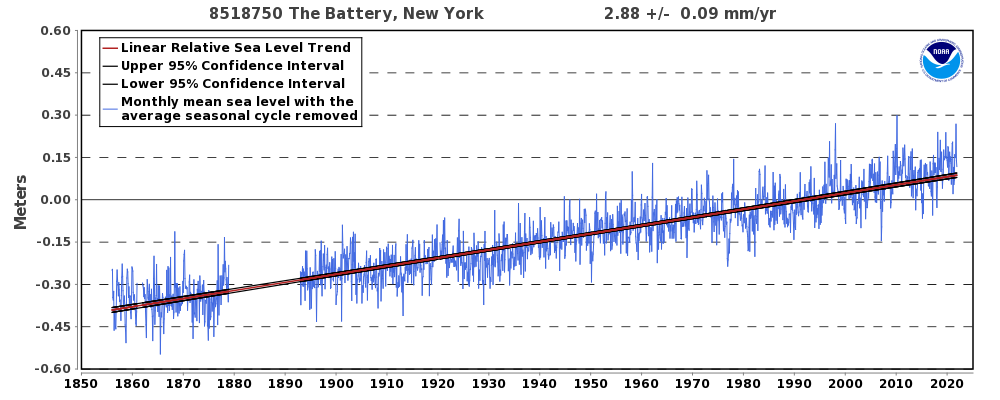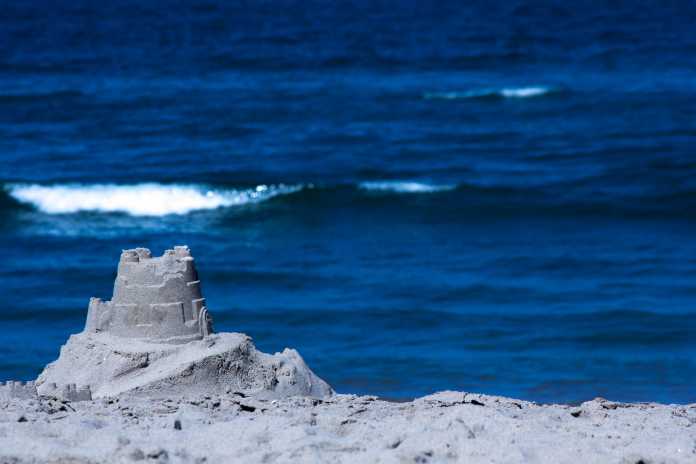CNN published a story about beachfront homes in North Carolina succumbing to coastal erosion. CNN blamed ‘climate change,’ causing rising seas, for North Carolina’s coastal erosion. This blame is misplaced. Coastal erosion and changing sea levels will inevitably occur—sometimes even to extreme degrees—regardless of human carbon dioxide emissions.
Coastlines change as part of natural and continuous cycles, and have since water formed on the planet. More recently on the geologic timescale, the last major glaciation (ice age) occurred in the Pleistocene. As shown in the image below from the USGS Coastal Change site, when there was more glacial ice there was a much wider coastline. As the earth rebounds from glaciation, it is reasonable to assume that sea level would change appropriately.

As described in the analysis found on the Sea Level Rise page of Climate at a Glance, sea level rise is within natural variation, rising at a slower rate now than it has for the vast a majority of time during the present interglacial period. There is potential for a minor human impact since the 1950s, though the debate is still ongoing as to whether or not acceleration of sea level rise is occurring, and how much (if any) is attributable to anthropogenic forcing.
Looking at the long-running East-Coast monitoring station at The Battery, New York, we can see that the trend of rise has been relatively constant since 1860. Prior to that, there was a decrease in sea level probably due in part to the “neoglaciation” during the Little Ice Age.

As an analysis from the National Oceanic and Atmospheric Administration of relative sea level trends for Northern Atlantic demonstrates, sea level can vary at even nearby regional stations. The below figure was selected because it includes stations from North Carolina, which have both one of the highest potential rates of sea level rise (Duck, NC) as well as one of the lowest (Southport, NC).

Even on a global scale, sea level rise is not consistent. As explored in two Heartland Institute reports, here and here, some regions have experienced greater or lesser rates of sea level rise, or even sea level retreat, depending on thermal expansion, tectonics, and other non-anthropogenic causes. Tectonically active coastlines can see higher rates of change than others, either by land being uplifted (resulting in negative sea level change) or due to land subsidence from development in wetlands and ground water withdrawals (resulting in more rapid positive sea level change).
Humans have seen massive sea level and coastline erosional change throughout history, well before the industrial revolution.
One example from antiquity would be when coastal erosion and repeated strong storms took one of the largest ancient towns of England. Dunwich, England was recorded in an eleventh-century regional survey book as having lost over half its farmland to the ocean as early as 1066 AD, and suffered more destruction from storms in the early 1300s. Over the next few hundred years the city continued to be battered by storms and crumble into the sea, until its last church toppled over the cliffside in 1919.
Beaches change with wave activity, storms, wind erosion, land subsidence, and other natural forces, and always will regardless of anthropogenic carbon dioxide. Besides adaptation or engaging in aggressive and active geo-engineering projects, like those done to in Holland and along the Mississippi River Delta (to varying levels of success), there is little that can be done to stop relentless changes in sea levels.

















